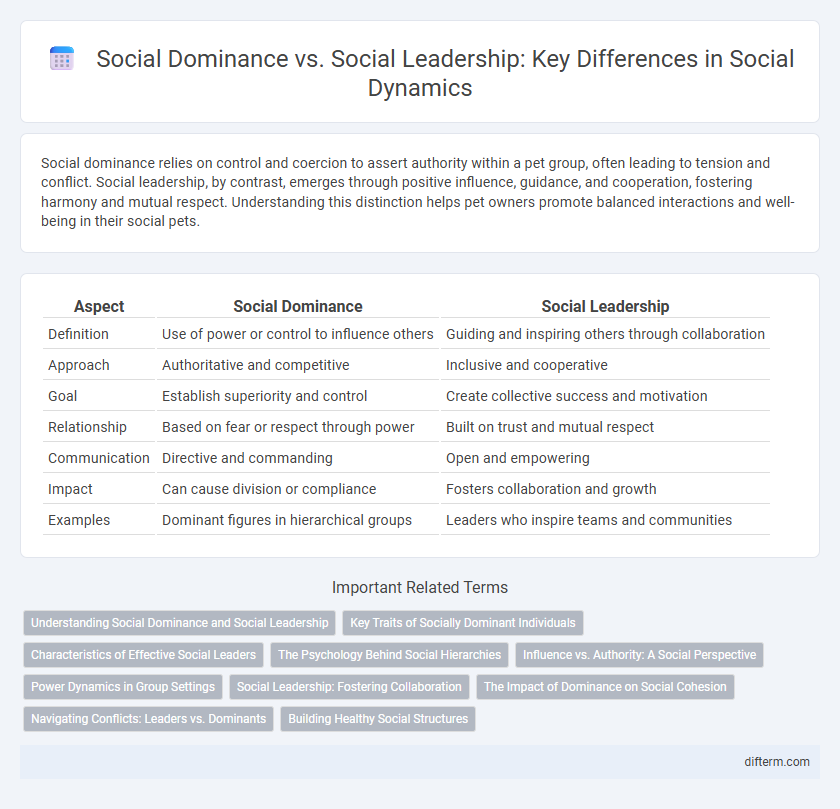Social dominance relies on control and coercion to assert authority within a pet group, often leading to tension and conflict. Social leadership, by contrast, emerges through positive influence, guidance, and cooperation, fostering harmony and mutual respect. Understanding this distinction helps pet owners promote balanced interactions and well-being in their social pets.
Table of Comparison
| Aspect | Social Dominance | Social Leadership |
|---|---|---|
| Definition | Use of power or control to influence others | Guiding and inspiring others through collaboration |
| Approach | Authoritative and competitive | Inclusive and cooperative |
| Goal | Establish superiority and control | Create collective success and motivation |
| Relationship | Based on fear or respect through power | Built on trust and mutual respect |
| Communication | Directive and commanding | Open and empowering |
| Impact | Can cause division or compliance | Fosters collaboration and growth |
| Examples | Dominant figures in hierarchical groups | Leaders who inspire teams and communities |
Understanding Social Dominance and Social Leadership
Social dominance involves asserting power and control through hierarchical status, often maintained by force or intimidation, while social leadership emphasizes influence through trust, cooperation, and effective communication. Understanding the distinction highlights that social dominance can create compliance, whereas social leadership fosters genuine followership and group cohesion. Recognizing these dynamics is crucial for developing healthy social environments and effective leadership strategies.
Key Traits of Socially Dominant Individuals
Socially dominant individuals exhibit traits such as assertiveness, confidence, and a strong desire to influence others, often prioritizing control over cooperation. They display high levels of competitiveness and willingness to take risks to maintain status within social hierarchies. Unlike social leaders who motivate and inspire through empathy and collaboration, dominant individuals rely on power and intimidation to assert their position.
Characteristics of Effective Social Leaders
Effective social leaders exhibit empathy, strong communication skills, and the ability to inspire trust and collaboration within diverse groups. Unlike social dominance, which relies on control and power, social leadership fosters inclusivity and mutual respect to achieve common goals. Key traits include emotional intelligence, adaptability, and a commitment to empowering others for sustained group success.
The Psychology Behind Social Hierarchies
Social dominance centers on asserting power through control and intimidation within hierarchies, often driven by competitive and aggressive behaviors. Social leadership, however, relies on influence, cooperation, and empathy to guide groups, fostering trust and collaboration. Psychological research highlights that while dominance establishes rank, leadership nurtures group cohesion and long-term social stability.
Influence vs. Authority: A Social Perspective
Social dominance relies on authority derived from status, coercion, or control, often establishing power through hierarchy and influence by fear or obligation. Social leadership emphasizes influence built on trust, respect, and collaboration, fostering voluntary followership and shared goals. The effectiveness of social leadership lies in its ability to inspire and motivate, whereas social dominance maintains compliance through imposed authority.
Power Dynamics in Group Settings
Social dominance centers on asserting power through control and hierarchy enforcement, often inducing compliance via authority or intimidation in group settings. Social leadership emphasizes influence built on trust, respect, and collaboration, fostering cooperative dynamics that encourage voluntary followership. Power dynamics reveal dominance as top-down enforcement, whereas leadership operates through mutual engagement that enhances group cohesion and performance.
Social Leadership: Fostering Collaboration
Social leadership centers on fostering collaboration by promoting shared goals and mutual respect within groups. Emphasizing empathy, communication skills, and inclusivity enhances team cohesion and drives collective success. Unlike social dominance, which relies on control and hierarchy, social leadership cultivates trust and cooperation to achieve sustainable social influence.
The Impact of Dominance on Social Cohesion
Social dominance often undermines social cohesion by fostering competition and fear rather than trust and collaboration. In contrast, effective social leadership promotes inclusion and mutual respect, strengthening group solidarity and cooperation. Research shows groups led by dominance-oriented individuals exhibit higher conflict rates and lower overall satisfaction compared to those with leadership focused on empathy and shared goals.
Navigating Conflicts: Leaders vs. Dominants
Social leaders prioritize collaboration and empathy to navigate conflicts, fostering trust and long-term cooperation within groups. In contrast, socially dominant individuals often rely on assertiveness and control, which can escalate tensions but quickly establish hierarchy. Effective conflict resolution balances the dominance needed to assert boundaries with the leadership skills that encourage mutual understanding.
Building Healthy Social Structures
Social dominance often relies on control and hierarchy to maintain order, whereas social leadership emphasizes collaboration and mutual respect to foster trust within groups. Building healthy social structures involves promoting inclusive decision-making processes that value diverse perspectives and encourage shared responsibility. Effective social leadership enhances group cohesion and resilience by prioritizing empathy and open communication over authoritarian influence.
social dominance vs social leadership Infographic

 difterm.com
difterm.com